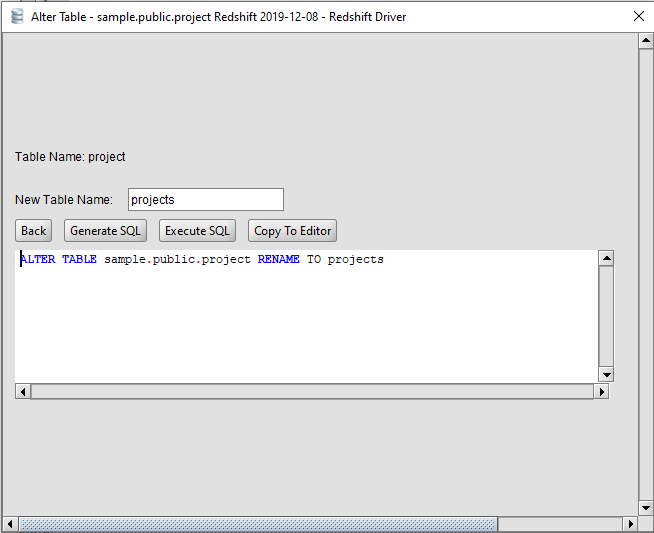

Operations except that table names and schema names Of BatchOperations this object is the same as The method is used as a context manager, which returns an instance Operation on other backends will proceed using standard ALTER TABLE SQLite backend, and only if directives are present which require The directive by default will only use “recreate” style on the The new table is renamed to the existing table name. The data copied from the existing table to the new table. Migration directives within the batch, using a temporary name. Modes of table migration, in particular the “recreate” style ofĪ new table is created with the new specification, based on the To be syntactically grouped together, and allows for alternate
#Postgresql rename table series#
Invoke a series of per-table migrations in batch.īatch mode allows a series of operations specific to a table batch_alter_table ( table_name : str, schema : str | None = None, recreate : Literal = 'auto', partial_reordering : tuple | None = None, copy_from : Table | None = None, table_args : Tuple = (), table_kwargs : Mapping =, naming_convention : Dict | None = None ) → Iterator ¶ AbstractOperations ( migration_context : MigrationContext, impl : BatchOperationsImpl | None = None ) ¶īase class for Operations and BatchOperations. Itself would be invoked by the n_migrations() Under normalĬircumstances they are called from an actual migration script, which The functions here all require that a MigrationContext has beenĬonfigured within the env.py script first, which is typically Objects, though the table metadata is still generated here. Rule include the add_column() and create_table() Given in terms of just the string names and/or flags involved. This so that migration instructions can be To the greatest degree possible, they internally generate theĪppropriate SQLAlchemy metadata, typically involving SeeĪ key design philosophy to the Operation Directives methods is that The Operations system is also fully extensible. So symbols can be imported safely from the alembic.op namespace. With individual proxies for each method on Operations,

To the script via the alembic.op datamember, which isĪ proxy to an actual instance of Operations.Ĭurrently, alembic.op is a real Python module, populated When migration scripts are run, this object is made available Within the upgrade() and downgrade() functions, as well asĪll directives exist as methods on a class called Operations. The directives here are used within user-defined migration files, Testdb=# SELECT C.ID AS COMPANY_ID, C.NAME AS COMPANY_NAME, C.AGE, D.This file provides documentation on Alembic migration directives. Let us see an example for the usage of COLUMN ALIAS where COMPANY_ID is an alias of ID column and COMPANY_NAME is an alias of name column − The above given PostgreSQL statement will produce the following result − Testdb=# SELECT C.ID, C.NAME, C.AGE, D.DEPT Now, following is the usage of TABLE ALIAS where we use C and D as aliases for COMPANY and DEPARTMENT tables, respectively − (b) Another table is DEPARTMENT as follows − The basic syntax of column alias is as follows −Ĭonsider the following two tables, (a) COMPANY table is as follows − The basic syntax of table alias is as follows − The column aliases are used to rename a table's columns for the purpose of a particular PostgreSQL query. Renaming is a temporary change and the actual table name does not change in the database. The use of table aliases means to rename a table in a particular PostgreSQL statement. You can rename a table or a column temporarily by giving another name, which is known as ALIAS.


 0 kommentar(er)
0 kommentar(er)
